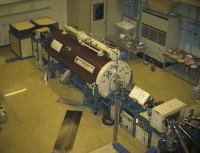HOME > Research > Research Facilities > Tandem electrostatic accelerator

with the objective of conducting education and research in the environment and energy scientific fields, including atomic and nuclear engineering, the Accelerator and Particle Beam Experiment Facility has a variety of radioisotopes (RI) and 400keV/130kA/60ns pulse ion implantation equipment, including the core equipment of an electrostatic accelerator (1.7-MV tandem pelletron 5SDH2). The accelerator is equipped with 5 beam ports (a P45 multiple irradiation with an analysis port, a P15 microbeam irradiation and low energy ion injection port, a M15 large area irradiation port for surface reforming, a M30 general purpose analysis port, and a M45 wavelength dispersion PIXE / sub-atomic analysis port)).
From the MeV ion beam generation, an ion beam with almost all of the elements can be generated from two types of stationary ion sources (cesium sputtering negative ion source (SNICS-II) and a RF discharge Rb charge conversion-type negative ion source).The negative ions are accelerated up to a high-voltage terminal maintained at a maximum of +1.7MV, where they are then converted into positive ions from a charge-stripping reaction with the nitrogen molecules. Next, toward the earth potential, they are re-accelerated to 3.4 / 10MeV energy, depending on the charge.
For the use of the MeV ion beam, that nano-scale / subatomic interaction between beam particles and material atoms / atomic nuclei are used, and it has the characteristic functions of (a) modification of the material's surface and introduction of new functions, and (b) distribution analysis of the elements within the material. These functions can be applied widely not only to science and engineering, but also to agriculture, medicine, pharmacy, biology, archeology, and the maritime sciences. The analytical methods employed include Rutherford Backscattering Spectroscopy (RBS), Elastic Recoil Detection Analysis (ERDA), Nuclear Reaction Analysis (NRA), and Particle Induced X-ray Emission (PIXE).
Researchers from outside of the University may also use the facility
http://www.research.kobe-u.ac.jp/fmsc-pbe/www/5sdh2/5sdh2_e.html